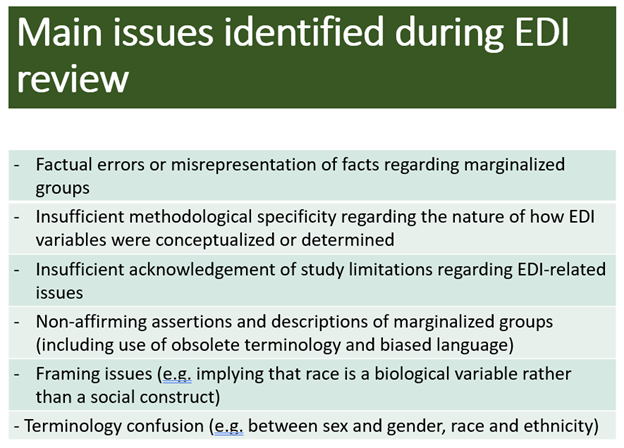 Roy H Hamilton, MD, MS, FAAN, who is one of two Associate Editors for Diversity, Equity, and Inclusion (DEI) for the Neurology® journals, published by the American Academy of Neurology.1 He is also professor of Neurology, Psychiatry, and Physical Medicine & Rehabilitation at Penn and Vice Chair of Diversity and Inclusion for the Department of Neurology.
Roy H Hamilton, MD, MS, FAAN, who is one of two Associate Editors for Diversity, Equity, and Inclusion (DEI) for the Neurology® journals, published by the American Academy of Neurology.1 He is also professor of Neurology, Psychiatry, and Physical Medicine & Rehabilitation at Penn and Vice Chair of Diversity and Inclusion for the Department of Neurology.
In this interview with Science Editor, Dr Hamilton discusses his role with the Neurology® journals as a DEI Editor focusing on broadening the definition of expert peer review and helping ensure that the journals use best publishing practices related to unbiased research and reporting.
Science Editor: Tell us about your job and organization. How did you get involved in an editorial role?
Dr Roy Hamilton: I’ve been involved in the American Academy of Neurology (AAN) for many years since I was a medical student, and I have benefited greatly from AAN programs. I received scholarships to meetings, participated in AAN’s Diversity Leadership Program, and advanced in my career as a recipient of a clinical training research fellowship. I’ve held a number of administrative roles at Penn related to diversity, equity, and inclusion, where I also run a research lab focused on the use of non-invasive brain stimulation (transcranial magnetic stimulation [TMS]) and transcranial electrical stimulation (tES) in neurology. As a researcher, I understand the peer-review process and was already engaged in editorial leadership activities for other journals and had knowledge of the scientific literature, so it seemed a logical step to move into the editorial arena when the journal’s editor-in-chief requested I take on this assignment in partnership with another DEI editor, Dr. H.E. Hinson.
SE: What led to the creation/expansion of your role in the journal Neurology?
Dr Hamilton: There was an incident in which an article with negative racial stereotypes was published in our Humanities section and offended our readers. It was obvious that there were gaps in the review process that allowed this to happen. The article was subsequently retracted, but the editors and staff decided to implement some major changes—including ongoing DEI awareness training for editors and staff, a focused website on DEI issues, updating of the journal’s style guide, and appointing two DEI editors who could review submitted papers for appropriate perspectives from a DEI viewpoint.
SE: What is the purpose of your role as a DEI Editor?
Dr Hamilton: We try to assist authors in ensuring the content is respectful and affirming to minoritized populations. These communities include minoritized racial and ethnic groups and sexual and gender minorities but could include other marginalized groups such as those with disabilities. We will offer suggestions, when appropriate, for best practices when describing these populations. Our role is not to serve as content censors.
SE: How do the DEI editors make decisions about what content for the Neurology journals should receive a DEI review? And when in the review process do you review manuscripts for DEI concerns? Can you describe the logistics of this process?
Dr Hamilton: Papers are often referred to us by the editor or a handling editor, but the DEI editors review all the titles of papers that are going to be invited for revision. We also follow up on notifications from staff if they notice something that was not addressed by reviewers or handling editors. DEI reviews are completed before invitations are sent to authors for revisions or later if there are still concerns.
SE: What are you looking for when you review titles or decide to read the abstract or a complete paper? Do you find you are approaching papers mainly from the standpoint of terminology or do you find yourself identifying conceptual issues in researchers’ reports involving different populations?
Dr Hamilton: Obsolete terminology and biased language are easier to identify, but we are also checking for methodological specificity in determining DEI variables and whether study limitations are acknowledged, in addition to other concerns about how populations are described.
SE: What DEI categories stand out for you as most problematic when you review these papers? (racial, ethnic, gender, sex, other?)
Dr Hamilton: Race and ethnicity concerns seem to surface about twice as often as sex or gender concerns, with fewer concerns in other marginalization categories.
SE: What are the main issues you’ve identified during DEI reviews of papers?
Dr Hamilton: We see factual errors regarding marginalized groups, lack of information about how DEI variables are determined, insufficient acknowledgment of study limitations when groups are not included, obsolete terminology and biased language, framing issues, and terminology confusion (see Figure).

SE: Do you know if papers are often rejected based on DEI concerns only?
Dr Hamilton: Authors are usually cooperative in addressing the concerns raised. So reviewing for DEI concerns leads to substantive corrections. Often, items can be changed with a tonal framing. Very rarely do we need to reject a paper based on DEI concerns only. Occasionally, we will reject if a paper is based on poor methodology so we are still acting as scientific content experts with DEI knowledge.
SE: What skills, abilities, and personal attributes have you found to be essential to success in your role?
Dr Hamilton: To state the obvious, I enjoy reading and reviewing scientific papers. In some ways, the job is to be a super-reviewer, one where you have to love reading and improving papers. This type of editing makes the DEI portions of a paper more coherent and helps improve the quality of a paper. In this role, I have to try to stay current as social constructs and societies change. It also takes a fair amount of flexibility and cultural humility. If you think your view of race or gender or other areas of diversity is the only way to think and that you are right, you’ll do a disservice. It’s important to constantly think of new ways to think. The lens through which you view the issues has to allow for changes, and you need to be willing to be humble to that. You also have to invest the energy to learn about something you haven’t been trained in. Other editors handle areas in which they have specific formal years of training. Editing for DEI comes from lived experience, other related experience, and experience doing the job. I am supposed to be the person to go to for this expertise and that motivates me to continuously learn this content. Unfortunately, there is no natural training pathway yet for DEI in neurology. We are trained formally in neurology, but becoming a specialist in DEI comes about more informally. Persons coming from other educational backgrounds may be better trained in DEI issues, but someone without training in neurology might have difficulty understanding the scientific and clinical content of the manuscripts they are reviewing and might struggle to perform the role of editor in a journal focused on neurology.
SE: What do you enjoy most about your role? What challenges do you face?
Dr Hamilton: What do I enjoy? I like the moment when I have received feedback from authors after I advised them about their manuscripts that indicate they were receptive to my comments—and treated the issues seriously and sensitively, whatever they decided to do with their paper. The intent of my comments is to motivate authors to face DEI issues in their papers, and they generally represent friendly advice on how to improve them. I enjoy seeing that the papers have been strengthened by that feedback. That way, not only will the data in the paper make an impact, but the way the authors are conveying the DEI issues will have an impact on the science around the data. After hundreds of articles, it makes you feel like you’ve changed something meaningful in science by doing this.
The challenges? There are two. The first is the demands of the job itself, having a high volume of articles to review and keeping up with a logical time demand and fast turnaround, but I am committed to not slowing down the review process with my work. I don’t ever want DEI editing to be a drag on the review process. The second is the limitation of expertise of my co-DEI editor and myself: DEI covers a huge editorial mission with many lanes, and in some of these spaces, we don’t have the scientific expertise to feel that we are on steady ground. Unfortunately, we can’t have expertise in all the subfields in neurology and neuroscience that are affected by DEI issues. For example, in genetic studies, it’s difficult for us to wade in and correct the science when looking at race and ancestry. Race is often used as a proxy for ancestry, but as non-geneticists, we struggle sometimes to make relevant, detailed recommendations. Also, people expect us to read articles on both health disparities and health research services and assume we have deep expertise in both, which isn’t necessarily the case. It is best to include reviewers who are researchers in those areas.
SE: What are some of the biggest changes you’ve seen in the industry and where do you see scientific editing and publishing heading?
Dr Hamilton: When I first took on this job, I felt like Dr Hinson and I were the only ones in this role, but now I’m seeing a lot of other DEI editors at many other journals. That’s clearly the biggest change I’ve seen.
As this role propagates across journals and matures, persons who do this job will have an increasingly clear understanding of what is important, not just from a social justice and equity perspective but also in terms of how attention to DEI improves the quality of science. DEI editors not only make sure a journal doesn’t commit errors in describing groups of people, but they also ensure that published data include more diverse populations and therefore contribute to the dissemination of more robust, generalizable discoveries. Scientific work is not generalizable, and ultimately is not as useful, if only persons from specific, homogenous backgrounds are included in the research. When considering the value of DEI editors, journals should absolutely think about advancing social justice, but they should also consider how their science mission is enhanced by the contribution of DEI editors.
Also, in my view, DEI editors will eventually play a role in the diversity and inclusivity of the journals themselves. Much could be done to make the workforce of journal editors, staff, and even reviewers more diverse. In a more holistic future role, DEI editors of journals will lead the charge to enhance diversity in this arena as well.
References and Links
- Hamilton RH, Hinson HE. Introducing the Associate Editors for Equity, Diversity, and Inclusion Aligning editorial leadership with core values in Neurology®. Neurology. 2019;93:651–652. https://doi.org/10.1212/WNL.0000000000008235
- RH Hamilton, HE Hinson, R Burch, JA Budhu, N Rosendale, PK Baskin, RA Gross, JG Merino. Assessment of Neurology’s implementation of equity, diversity, and inclusion editorial review of research manuscripts. International Congress on Peer Review and Scientific Publication; 2022. [accessed March 5, 2023.] https://peerreviewcongress.org/abstract/assessment-of-neurologys-implementation-of-equity-diversity-and-inclusion-editorial-review-of-research-manuscripts/.
Patricia K Baskin, MS, is Executive Editor, Neurology® Journals.
